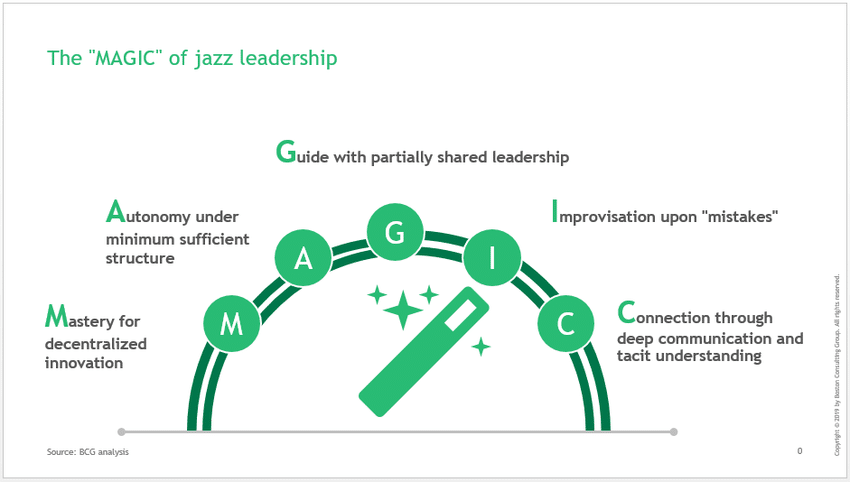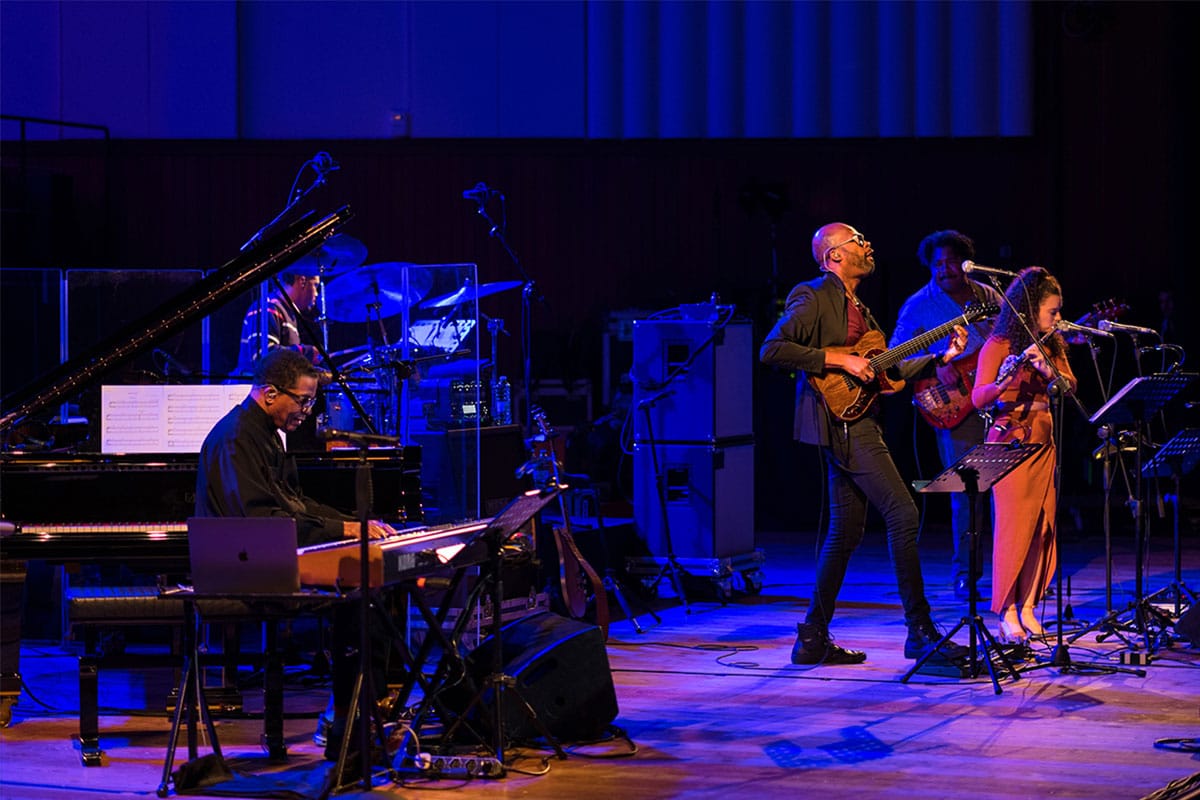Leadership and Jazz. Yesterday I attended the Herbie Hancock concert at the Conservatorio of Milan, opening act of the JazzMi Festival. It was a genuinely great experience, to see such a master of jazz play. We had perfect placing (third row). Not more than 10 meters separated us from this real master. But am not here to comment on the (exceptional) music. Instead, as the concert rolled, I could observe a few behaviours that should resonate in an organisational context. Jazz can become a powerful metaphor of (proper) management, particularly in a moment where technologies are causing disruptions, and Digital Maturity is becoming a “must-have”.
Jazz and Leadership: a metaphor through time
The association of Leadership and Management to music is not new. The metaphor of the Orchestra Director as a true Leader is known. But what is striking about a jass ensemble is that there is nothing like a visible director that stands on a podium and directs the music. So the idea that Jazz can teach Management Lessons diffused itself already some time ago. Grant Ackerman from Columbia Business School wrote an interesting article about this in 2018, identifying four leadership lessons from Jazz. Previously before this in 2012 Frank J. Barrett jazz pianist and professor of management at the Naval Postgraduate School in Monterey published the book: Yes to the Mess: Surprising Leadership Lessons from Jazz. In an interview later given to Harvard Business Review, he speaks primarily of the concept of an Improvisational Mindset, which is the Yes part to the Mess.
You say yes to the mess by surrendering control-by opening yourself up to the capriciousness of the crowd, with no guarantee of success for your efforts. Ultimately, that takes one quality above all others: courage.
Frank J. Barrett, Yes to the Mess: Surprising Leadership Lessons from Jazz
After this post, I read the book by Frank Barrett.
Barrett has identified 7 Improvisation Principles in his research, and solidly put in place a real rational concept for Jazz as a metaphor of management. But already in 1990, the BCG CEO John Clarkeson wrote an article titled Jazz vs Symphony.
The winning organization of the future will look more like a collection of jazz ensembles. Leaders will be in the flow, not remote; they will not be able to rely on exclusive decision-making authority; they will use the conflict among diverse points of view to reach new insights. The distinctions between composer/conductor/performer are eroding.
John Clarkeson, Jazz vs. Symphony.
This was recently explored even more in detail by Fang Ruan, Partner at BCG, in a post titled What business leaders can learn from Jazz. In it, he identifies five characteristics of the Jazz Leadership, that he defines as “Magic”.

What is really important?
I do relate a lot personally on this concept and can still recall one of the first management programmes that I designed when I was working ad Diesel, which was titled “Get Into the Groove”. The programme, focused on Store Managers, was precisely looking at the concept of “being in the groove” as a leadership metaphor. The Store Manager cannot be in store all the time, so how do you ensure that excellent customer service is anyway performed all the time? Plus the Store Manager is also working on the shop floor. The metaphor of the orchestra director simply could not apply.

As I watched the concert yesterday, I could distil two sets of elements that are important for an organisation today. Some are behaviours, both of the leader and the components of the jazz band. Some others are instead part of the Organizational Tissue of the band.
Behaving like a Jazz Band
- Active Listening: I could observe Herbie Hancock during most of the concert, in the moments when he was less “engaged” in the act of playing, carefully listening to the rest of the band. Smiling, keeping the rhythm, supporting the others. It was a clear example of active listening in practice, something that is not always visible. And when he presented the artists, he mentioned how much he learns from them all the time!
- Taking turns Leading. The leader allows all the members of the band to take their turn at leading. This is not only through the solos of each member of the brand, but by letting each team member adding their contribution, and creating “rest moments” during a concert that others can fill.
- Humility. Whenever I think of the concept of a Jam Session, I conceptually don’t get it. How can skilled people, risk of not “arguing” during a session about the best way to proceed with the melody? It works because all artists follow the guiding principle of serving the music. They leave their Egos at the door and help and support each other to create something bigger and better. I wish customer service would work the same way in most organisations!.
Organising like a Jazz Band
- Not having a plan. Miles Davis once said: “Do not fear mistakes. There are none.” In Jazz, a note is neither right nor wrong. It’s the note that follows that will make the difference. By focusing on the framework rather than on the execution of always the same melody, you can better adapt the results to the situation. If the public needs more energy, you can put it in. If you need to be more relaxed, you can do that. You can adapt to locations, to equipment limitations, to different types of audiences. Results will always vary a little, but will still be extraordinary. Which means creating and mastering the art of real flexibility.
- Living in the Groove. The music written on paper is only a framework for artists to work and continuously evolve. This requires that individual mastery is steadily pursued (continuous learning) and that each individual supports the other. That’s why roles, although existing, are not “mandated”. In a jazz band, all parts have the same impact on the result. Their importance can vary depending on the moment, on the groove. Look at the drums or the bass: in other music arts these are often accompanying instruments only, here they can have a much more critical role. But always in relationship to the whole. This also means that people enjoy guided autonomy into these plays.
- Built for Unlearning: what strikes me the most about a Jazz Ensemble is that the most successful ones are continually innovating. And they do so by continually rethinking what worked in the past. They can apply a new rhythm, introduce a new instrument, often starting from the initiative of one of the members. The fact that each performance is different from the one before means that a continuous unlearning-learning loop becomes a fundamental design principle for the organisation.
Jazz and Leadership the New Organisation
The concert yesterday was concluded with a big moment, in which most of the audience left its seat and went down under the stage. Waving hands, dancing, recording with their phones. All very near to the band creating a genuine atmosphere of celebration. And the energy of the group was just incredible.

For sure the set up of the auditorium allowed this. Still, it made me think of yet again another essential aspect, the vicinity that jass bands usually create with their public (as opposed to the rigid division that happens with a classical orchestra). This aspect, often more visible in a Jazz Club, is yet another element that makes me reflect on the analogy between Jazz and what is needed for management and leadership today in organisations.
To recap, I think we need to take these examples both in the competencies but also principles for Designing our organisations. It becomes an excellent illustrative framework for a lot of the ideas that I’ve already been sharing, both in terms of competences (read here about the Key Skills to compete in the Future of Work) and organisational design (for example with the strong parallel with design thinking principles).
And you? What do you think of Jazz as a metaphor for leadership?

Cover Photo: Herbie Hancok playing in Milan. Photo by Giulio Giacconi/RollingStone.it


[…] world of Management and Leadership. After attending the Herbie Hancock concert in Milan, I wrote a post on the relationship between Jazz and Leadership. I did some research on the web, and that’s how I found this book. Written by Frank J. […]
[…] concept we have also discovered when we have seen the relationship between Leadership and Jazz (further explored in the book Yes to the Mess I’ve just reviewed). Each Jam Session is good […]
[…] easy to notice how there’s a definitive reference in wording on the Groove and the Jazz Concept we have seen already covered by the last book I reviewed Yes to the Mess by Frank […]
[…] in Yes to the Mess by Frank J. Barrett. As he illustrates the parallel between Jazz Improvisation and how teams work, he defines the idea of improvising within a framework very […]
I really appreciate your time of putting theory’s into example by you using jazz band, need a book website to read more